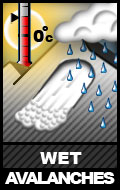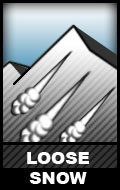Advisory based on observational knowledge and weather forecast available at time of posting (12am). Accuracy is subject to temporal and spatial variability and expires in 24 hours. Read the disclaimer and conduct your own assessment of conditions accordingly.
Saturday:
What you need to know:
While the avalanche danger is moderate, current snow conditions still demand careful evaluation in order to determine the specific avalanche concerns and danger level in the area in which you’re traveling. Dangerous avalanches conditions may still exist in certain areas, especially wind loaded southerly aspects and later in the day on slopes receiving the most solar radiation and warming (south to west aspects).
Danger trend:
Increasing through the day on warming, sun-exposed slopes. The wind slab danger should be on a slow decline due to forecast decreasing wind speeds and bonding time.
Avalanche Concerns:
Northerly winds picked up significantly on Friday, loading southerly aspects as evidenced by widespread pluming of the loose, dry snow from recent storms (that had not yet really been wind affected) throughout the Front Range and Eagle River area Chugach.
Expect the danger to be the highest on south to west aspects later in the day (late afternoon to early evening). Warmed, moistened slopes will likely be susceptible to significant human triggered sluffing by afternoon.
Human triggered sluffing will be an issue to contend with on steep slopes , especially warmed and moistened south to west aspects later in the day. This type of sluffing snow will be relatively heavy and wet (packing more punch). Human triggered sluffing is also likely on steep north facing terrain, but this snow will pack less punch due to it being lighter and drier.
Travel Advice:
In assessing the wind slab concern, be on the lookout for some of the typical characteristics like a rounded, pillowy look and/or hollow, slabby feel. Wind slabs will likely be found on leeward aspects (southerly) in upper elevation starting zones, on steep rollovers, and in cross-loaded terrain (like gullies).
Pay attention to the sun’s effect on the slopes. Look for rollerballs, point releases, sun induced sluffs, and other signs that the sun is significantly warming and decreasing stability on exposed slopes. When temperatures warm and solar radiation increases significantly, the wet avalanche danger will increase.
As always, be on the lookout for red flags of instability like recent avalanches, shooting cracks, collapsing or whumphing. What do these signs tell you about the stability in the area through which you’re traveling and how should you adjust your plans accordingly?
Mountain Weather:
Saturday is forecast to present us with mostly sunny skies, mountain temperatures in the upper teens to 20s, and variable light winds.
Avalanche Outlook:
Sunday, April 14
Forecast decreasing wind speeds should keep the wind slab danger on the decline, but wind slabs may still be a primary concern Sunday. Forecast sunny skies and associated warmth and solar radiation will continue to keep wet avalanches as a primary concern.




